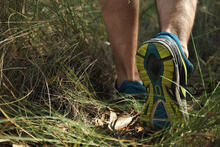About Spotted Fever Rickettsiosis
Spotted fever rickettsiosis (SFR) is rare in Wisconsin. SFR is spread by the bite of an infected tick.
Rocky Mountain spotted fever (RMSF) is the most severe of all SFR. The bacterium Rickettsia rickettsii causes RMSF. The disease is spread by infected wood ticks, also known as American dog ticks.
Wood ticks are commonly found in open grassy or wooded areas throughout the state, but they rarely spread disease in Wisconsin. Wood ticks are most active in our state during April through August, but it’s important to use caution year-round.
Very little is known about which other spotted fever bacteria are spread in Wisconsin, if any. All types of SFR are rare throughout the Upper Midwest.
SFR cases occur throughout the United States, most commonly in south-central and southeastern states. SFR can range from relatively mild to life threatening.
Anyone can get SFR, but it can be more severe in:
- Children under 10 years old.
- Older adults.
- Those with weakened immune systems.
Protect yourself with Tick Bite Prevention
Rocky Mountain spotted fever 101
In Wisconsin, Rocky Mountain spotted fever can be spread to people through the bite of an infected wood tick. It’s important to remove ticks as soon as they are found to prevent illness.
Adult wood ticks commonly bite people, but rarely spread RMSF in Wisconsin.
- Adult wood ticks are typically active during April through August.
- Adult wood ticks are relatively large, but people may not feel their bite.
Immature ticks are called larvae and nymphs.
- Immature wood ticks are typically active during April through September.
- Immature wood ticks are very small. They’re capable of spreading RMSF, but don’t commonly bite people.
Ticks can attach to any part of the body. They often are found in hard-to-see areas, such as:
- Behind the knees.
- In the armpits.
- On the scalp.
- In and around the ears.
- Inside the belly button.
- On the groin.
RMSF, and all SFGR, are preventable and treatable. Learn more about Tick Bite Prevention and how to properly remove a tick if you are bitten.
Symptoms can show up three to 12 days after being bitten by an infected tick.
Early signs and symptoms are usually mild. However, if untreated, the disease can quickly progress to a serious, life-threatening illness. Those who recover from serious illness can have long-term health problems.
Common signs and symptoms
- Fever
- Headache
- Rash (usually appears two to four days after fever begins)
- Nausea and/or vomiting
- Stomach pain
- Muscle pain
- Lack of appetite
Long-term health problems
- Amputation of arms, legs, fingers, or toes (from damage to blood vessels in these areas)
- Hearing loss
- Paralysis
- Mental disability
RMSF can be treated with antibiotics. Doxycycline is the antibiotic of choice for people of all ages. It is important to get treatment as soon as possible after symptoms start.
Treatment after a tick bite is not recommended to prevent RMSF or any other SFR, and may just delay illness. Instead, if you get bitten by a tick, be alert for the symptoms listed above. Call your doctor if you develop fever, rash, or other symptoms.
Resources from the Department of Health Services (DHS)
- Education on the risk posed by illnesses spread by ticks—Tickborne Diseases Risk in Wisconsin, P-01751 (PDF)
- Educational tri-fold card about ticks in Wisconsin, proper removal, and tick bite prevention—Tick Safety Guide, P-01434
- Fact sheet with simple steps to take—Protecting Your Family From Mosquitoes and Ticks, P-02080 (PDF)
Resources from the CDC
- Symptoms, treatment, diagnosis, epidemiology and more:
- Plastic trail sign to remind hikers there are ticks in the area—Prevent Tick Bites (PDF). Order the sign from CDC Info on Demand
- Educational comic for kids—Don't Let a Tick Make You Sick (PDF)
- Educational crossword for kids—Don't Let a Tick Make You Sick (PDF)
Resources
- Information from the University of Wisconsin-Madison Medical Entomology Laboratory—Wisconsin Ticks and Tick-borne Diseases
- Information on ticks found in the Midwest, surveillance resources, and tick biology and development from the Midwest Center of Excellence for Vector-Borne Diseases—Ticks
Contact us
Questions about illnesses spread by ticks? We’re here to help.
Bureau of Communicable Diseases
Phone: 608-267-9003
Fax: 608-261-4976

